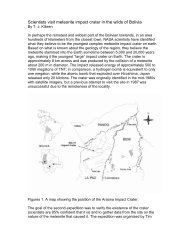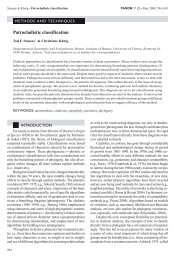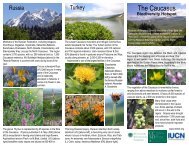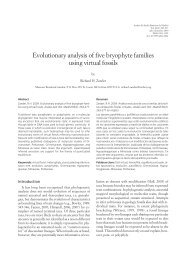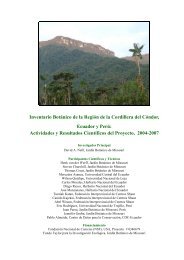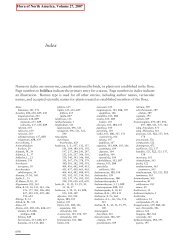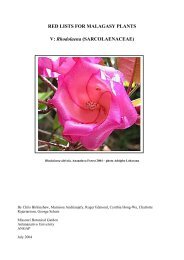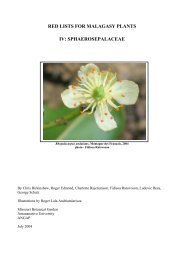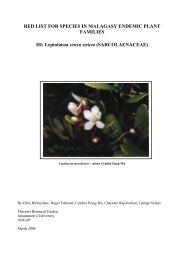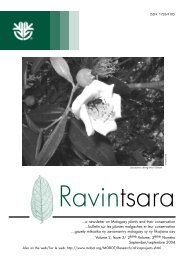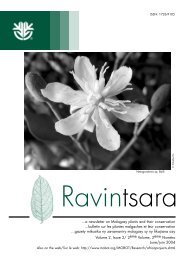phylogeny of campanulaceae s. str. inferred from its sequences of ...
phylogeny of campanulaceae s. str. inferred from its sequences of ...
phylogeny of campanulaceae s. str. inferred from its sequences of ...
Create successful ePaper yourself
Turn your PDF publications into a flip-book with our unique Google optimized e-Paper software.
562 Annals <<strong>str</strong>ong>of</<strong>str</strong>ong> the<br />
Missouri Botanical Garden<br />
wahlenbergioid genera. This is surprising because<br />
this species has traditionally been considered as<br />
typically wahlenbergioid. It has a chromosome<br />
number <<strong>str</strong>ong>of</<strong>str</strong>ong> 2n 36, which is not particularly unusual,<br />
but it is isolated in western Europe, and has<br />
a vegetative morphology that is rather atypical for<br />
the wahlenbergioids. Although all modern European<br />
workers have never questioned the wahlenbergioid<br />
nature <<strong>str</strong>ong>of</<strong>str</strong>ong> W. hederacea, this species was<br />
recognized as a separate genus by some early workers<br />
(Schultesia Roth, Valvinterlobus Dulac, Aikinia<br />
Salisb. ex A. DC.) and it was assigned to Roucela<br />
by Dumortier (1827). The majority <<strong>str</strong>ong>of</<strong>str</strong>ong> species <<strong>str</strong>ong>of</<strong>str</strong>ong><br />
Wahlenbergia are di<strong>str</strong>ibuted in the Southern Hemisphere.<br />
Some species (e.g., W. trichogyna Stearn)<br />
have 2n 36, but the majority have 2n 18 (see<br />
also Petterson et al., 1995; Crawford et al., 1994;<br />
Anderson et al., 2000). In the study <<strong>str</strong>ong>of</<strong>str</strong>ong> Cosner et<br />
al. (2004), the Au<strong>str</strong>alian species, W. gloriosa Lothian<br />
(not sampled), was found to be in the same<br />
clade as Roella ciliata L.<br />
The campanuloid group (Campanula s. <strong>str</strong>., ‘‘transitional’’<br />
taxa, and Rapunculus clades). This<br />
huge group forms an unresolved polytomy consisting<br />
<<strong>str</strong>ong>of</<strong>str</strong>ong> two major clades and three smaller ones. This<br />
basic division is partially in agreement with mode<br />
<<strong>str</strong>ong>of</<strong>str</strong>ong> capsule dehiscence (there are exceptions such<br />
as Edraianthus in the Campanula s. <strong>str</strong>. clade and<br />
Adenophora and subsection Heterophylla in the Rapunculus<br />
clade) and presence or absence <<strong>str</strong>ong>of</<strong>str</strong>ong> calyx<br />
appendages, two characters that have traditionally<br />
been used in intrageneric classifications <<strong>str</strong>ong>of</<strong>str</strong>ong> Campanula<br />
(Boissier, 1875, 1888; Fedorov, 1957). One<br />
large, well-supported clade (81%) comprises those<br />
taxa centered around Campanula s. <strong>str</strong>. (i.e., mostly<br />
those taxa belonging to the sect. Medium DC.), but<br />
also genera such as Trachelium, Diosphaera, Azorina,<br />
etc. The second large clade has moderate support<br />
(69%) and comprises those taxa centered<br />
around Campanula sect. Rapunculus (Fourr.) Boiss.<br />
(the Rapunculus clade). Two smaller clades have<br />
<strong>str</strong>ong support (100%) and consist <<strong>str</strong>ong>of</<strong>str</strong>ong> several transitional<br />
genera such as Jasione L., Musschia, and<br />
Gadellia Shulkina, while the third small clade comprises<br />
Wahlenbergia hederacea alone.<br />
THE CAMPANULA S. STR. CLADE<br />
The Campanula s. <strong>str</strong>. clade includes a small<br />
number <<strong>str</strong>ong>of</<strong>str</strong>ong> mostly monotypic genera that are considerably<br />
more divergent than the majority <<strong>str</strong>ong>of</<strong>str</strong>ong> taxa<br />
in this clade. Some have upright flowers (e.g.,<br />
Trachelium caeruleum L., Diosphaera rumeliana<br />
(Hampe) Bornm., Feeria angustifolia (Schousb.)<br />
Buser, Campanula [subg. Roucela (Dumort.) J.<br />
Damboldt] erinus L., Campanula mollis L., and<br />
Campanula edulis Forssk.), but Azorina vidalii<br />
(Wats.) Feer, with <strong>its</strong> nodding flowers, is a conspicuous<br />
exception. With Trachelium removed, boot<strong>str</strong>ap<br />
support for this clade is 93%. Campanula<br />
(subg. Roucela) erinus (2n 28) belongs to a rather<br />
distinct group <<strong>str</strong>ong>of</<strong>str</strong>ong> annual campanuloids <<strong>str</strong>ong>of</<strong>str</strong>ong> the Mediterranean,<br />
which superficially resemble C. mollis<br />
and C. edulis, but <strong>its</strong> capsules are discoid and the<br />
calyx appendages are absent. The corolla approaches<br />
the hypercrateriform shape <<strong>str</strong>ong>of</<strong>str</strong>ong> Trachelium corollas<br />
to some extent. The flowers <<strong>str</strong>ong>of</<strong>str</strong>ong> Diosphaera Buser<br />
are quite similar to those <<strong>str</strong>ong>of</<strong>str</strong>ong> Trachelium and it has<br />
the same chromosome number (2n 34), but there<br />
are conspicuous differences between the two genera,<br />
both vegetatively and in the form <<strong>str</strong>ong>of</<strong>str</strong>ong> the inflorescence.<br />
The two genera are <<strong>str</strong>ong>of</<strong>str</strong>ong>ten united, but they<br />
are disjunct geographically in the Mediterranean.<br />
Calyx appendages are absent in both genera.<br />
Azorina Feer is quite isolated morphologically<br />
(vegetatively and in branching pattern), but <strong>its</strong><br />
vague resemblance to Campanula bravensis Bolle<br />
and C. jacobaea C. Smith <<strong>str</strong>ong>of</<strong>str</strong>ong> the Cape Verde Islands,<br />
together with <strong>its</strong> chromosome number <<strong>str</strong>ong>of</<strong>str</strong>ong> 2n<br />
56, may link it rather tenuously to Campanula<br />
subsect. Oreocodon Fed. (but see also Thulin, 1976:<br />
354). Support for the clade that comprises Azorina,<br />
Feeria, Campanula mollis, and C. edulis is weak<br />
(58%), but when Azorina is removed support for the<br />
remaining taxa is 100%. Feeria angustifolia has<br />
traditionally been associated with Trachelium, but<br />
morphologically it is quite distinct. In some respects,<br />
particularly the globular, more compact<br />
shape <<strong>str</strong>ong>of</<strong>str</strong>ong> the inflorescence, and the valvate apical<br />
dehiscence, it approaches Jasione L., but the chromosome<br />
number for Feeria angustifolia is 2n 34<br />
(vs. 2n 12 for Jasione). The similarity <<strong>str</strong>ong>of</<strong>str</strong>ong> <strong>its</strong> ITS<br />
<strong>sequences</strong> with those <<strong>str</strong>ong>of</<strong>str</strong>ong> both Campanula mollis and<br />
C. edulis does not accord with <strong>its</strong> morphology. Campanula<br />
mollis and C. edulis are probably closely<br />
related to each other, and this relationship is<br />
<strong>str</strong>ongly supported in the ITS tree (96%). These two<br />
species belong to a group <<strong>str</strong>ong>of</<strong>str</strong>ong> annual and perennial<br />
campanuloids (2n 24, 28, 54, 56), which range<br />
<strong>from</strong> Macaronesia, North Africa, and the Iberian<br />
Peninsula south to the equator in Tanzania. They<br />
have basal dehiscence and appendages between the<br />
calyx lobes (Maire, 1929; Quézel, 1953; Thulin,<br />
1976). This group probably links up with Campanula<br />
subsect. Oreocodon <<strong>str</strong>ong>of</<strong>str</strong>ong> the western Himalayas<br />
and south-central Asia, which is characterized by<br />
species such as C. incanescens Boiss., C. cashmeriana<br />
Royle, and C. colorata Wall.<br />
The remaining taxa in the Campanula s. <strong>str</strong>.<br />
clade are weakly supported (58%) as a monophy-





